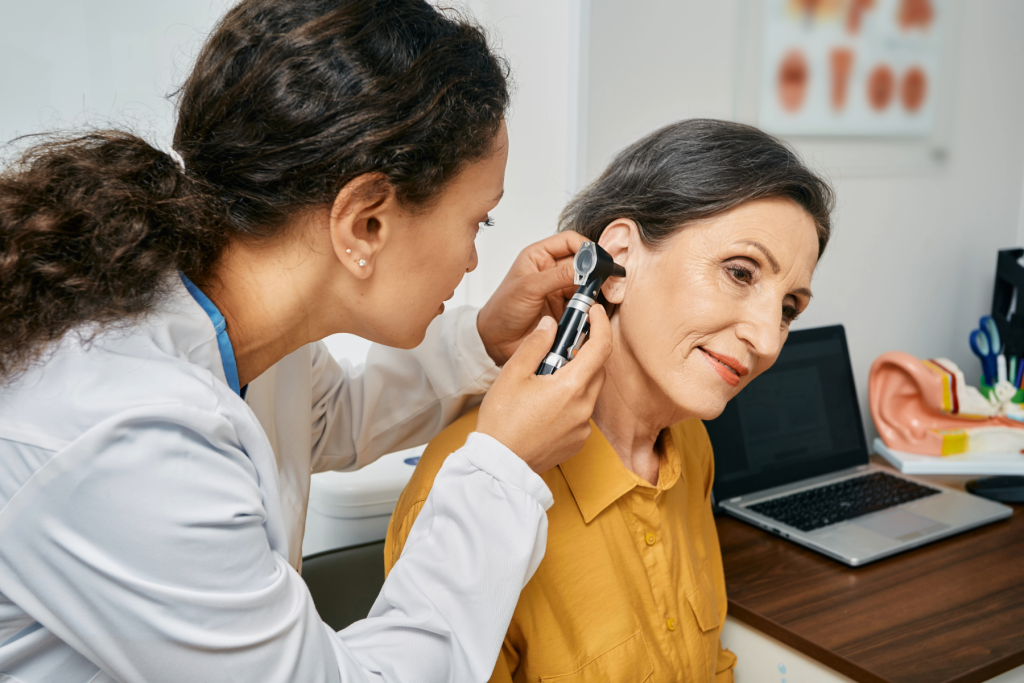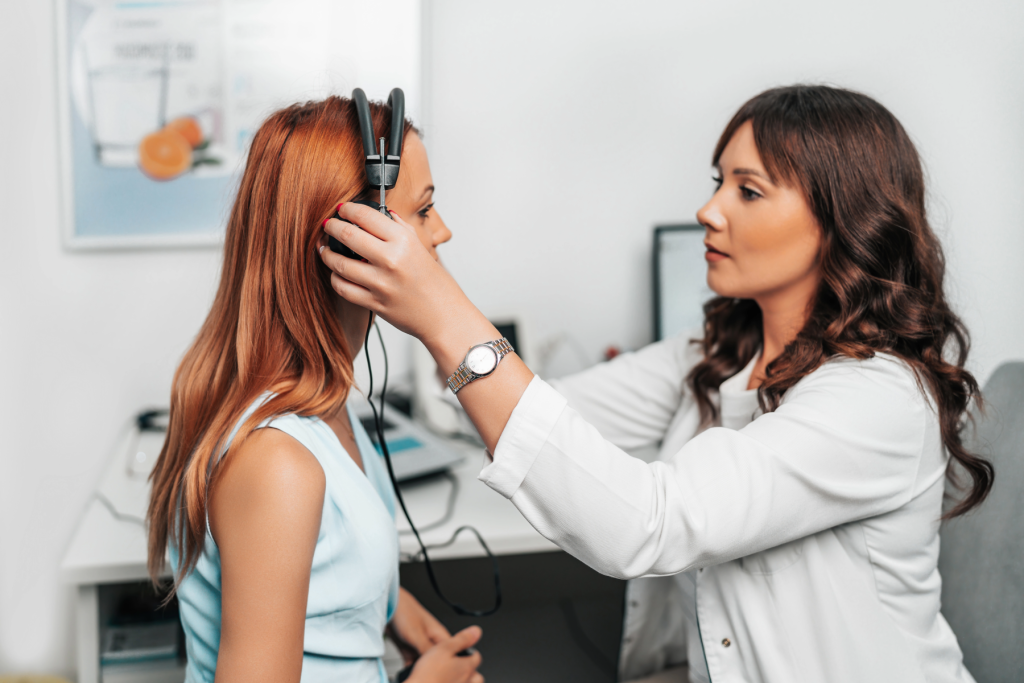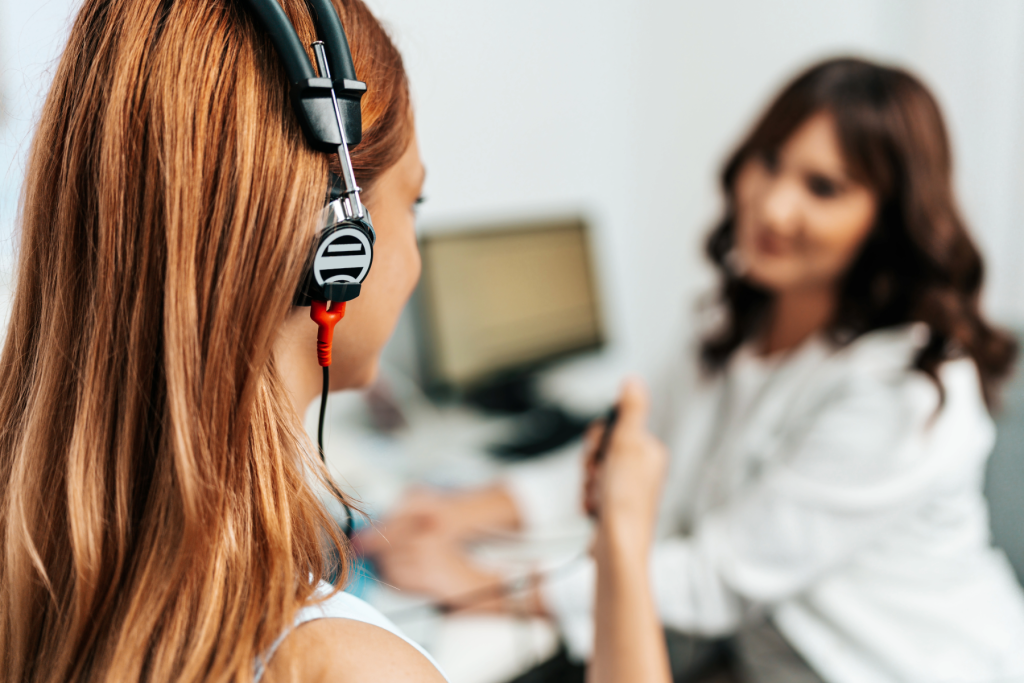


Hearing Evaluations & Testing
Better hearing starts with knowing where you stand. If you’re experiencing hearing loss or related concerns, audiology testing can provide the answers you need. Our comprehensive diagnostic exams help identify the type, cause, and severity of hearing issues—so we can recommend the most effective treatment for you.
Accurate diagnosis leads to better outcomes, and our testing offers a personalized path forward. Audiological evaluations are often recommended after an initial screening suggests a potential issue, giving you a deeper understanding of your hearing health. You deserve to hear life clearly—and we’re here to help make that possible.
Types of Hearing Evaluations
Audiogram
This hearing test uses sounds of specific frequencies and intensity levels to determine what a person can hear in each ear. The sounds are heard through headphones, and the patient is asked to identify each sound and the ear in which it was heard. The sounds become fainter and fainter, ultimately determining the lowest level at which a patient can hear. An audiogram includes speech testing in the form of two-syllable words to determine how soft a patient can hear and repeat back words with 50% accuracy. Word recognition testing involves repeating phonetically-balanced words at a comfortable volume to determine how well a patient can comprehend what is being heard.
Tympanometry
This form of testing examines and diagnoses problems in the middle ear by varying air pressure in the ear canal to see how the ear responds. A probe is inserted into the ear to change the air pressure, produce a tone and measure the responses. The patient may not speak, move or swallow during the test because doing so can affect ear pressure. Tympanometry measures the functionality of the eardrum (tympanic membrane). Abnormal findings may be the result of fluid in the middle ear, a perforated eardrum or impacted ear wax.
Acoustic Reflex Testing (including Decay)
The acoustic reflex (AR) or the reflexive contraction of the middle ear muscles in response to sound stimulation has a long history of clinical use for identifying middle ear, cochlear and VIIIth-nerve disorders. “Acoustic Reflex tests” provide information for the differential diagnosis of hearing loss. The results can provide and/or confirm information about the type (conductive, sensory, or neural) and degree of hearing loss. “Reflex Decay tests” can be useful in detecting and/or confirming retrocochlear pathology in patients. Generally, patients who present with typical retrocochlear indicators or symptoms (such as unilateral tinnitus, asymmetrical hearing loss, and/or dizziness/vertigo) are warranted a referral to an ENT Specialist without needing to do this test. However, the Reflex Decay test may be useful when the audiogram and case history is normal, but the reflex results indicate a retrocochlear pattern.
The Acoustic Reflex tests are painless and are performed by putting a small probe into the ear canal and presenting a loud tone. The stapedial muscle will contract in response to the tone and the reflex is measured on a computer. About 5% of the adult population will have absent acoustic reflexes.
Eustachian Tube Function Tests
Normal Eustachian tube function is necessary for maintaining healthy middle ear conditions. Eustachian tube dysfunction may occur when the mucosal lining of the tube is swollen or does not open or close normally. If the Eustachian tube is not functioning normally, symptoms such as muffled hearing, ear pain, tinnitus (ringing of the ears), reduced hearing, a sensation of fullness in the ear, or problems with balance may occur. The Eustachian Tube Function test is a tympanometric pressure swallow test that assesses ET function behind an intact tympanic membrane (ear drum).
This test is painless and performed by obtaining a baseline tympanogram and then mechanically creating positive and negative air pressures by having the patient swallow or sip water.
Otoacoustic Emissions Testing (OET)
Otoacoustic emissions testing (OAE) measures response to a sound from the cochlea or the inner part of the ear. The hair cells inside the cochlea vibrate in response to sound. These vibrations produce a nearly inaudible sound that echoes back into the middle ear.
This test is performed by inserting a microphone and two speakers into the ear to emit a sound and then recording the response signal. The test is often performed on children when hearing loss is a possibility. An OAE may also be conducted as part of the newborn hearing screening process. Absent or very soft response signals may be a sign of hearing loss, fluid behind the ears, or damage to the cochlea.
Reconnect with the sounds that matter most.
Contact us to get started on your hearing care journey.


Hearing Evaluations
Better hearing starts with knowing where you stand. If you’re experiencing hearing loss or related concerns, audiology testing can provide the answers you need. Our comprehensive diagnostic exams help identify the type, cause, and severity of hearing issues—so we can recommend the most effective treatment for you.
Types of Hearing Evaluations
Accurate diagnosis leads to better outcomes, and our testing offers a personalized path forward. Audiological evaluations are often recommended after an initial screening suggests a potential issue, giving you a deeper understanding of your hearing health. You deserve to hear life clearly—and we’re here to help make that possible.
Audiogram
This hearing test uses sounds of specific frequencies and intensity levels to determine what a person can hear in each ear. The sounds are heard through headphones, and the patient is asked to identify each sound and the ear in which it was heard. The sounds become fainter and fainter, ultimately determining the lowest level at which a patient can hear. An audiogram includes speech testing in the form of two-syllable words to determine how soft a patient can hear and repeat back words with 50% accuracy. Word recognition testing involves repeating phonetically-balanced words at a comfortable volume to determine how well a patient can comprehend what is being heard.
Tympanometry
This form of testing examines and diagnoses problems in the middle ear by varying air pressure in the ear canal to see how the ear responds. A probe is inserted into the ear to change the air pressure, produce a tone and measure the responses. The patient may not speak, move or swallow during the test because doing so can affect ear pressure. Tympanometry measures the functionality of the eardrum (tympanic membrane). Abnormal findings may be the result of fluid in the middle ear, a perforated eardrum or impacted ear wax.
Acoustic Reflex Testing (including Decay)
The acoustic reflex (AR) or the reflexive contraction of the middle ear muscles in response to sound stimulation has a long history of clinical use for identifying middle ear, cochlear and VIIIth-nerve disorders. “Acoustic Reflex tests” provide information for the differential diagnosis of hearing loss. The results can provide and/or confirm information about the type (conductive, sensory, or neural) and degree of hearing loss. “Reflex Decay tests” can be useful in detecting and/or confirming retrocochlear pathology in patients. Generally, patients who present with typical retrocochlear indicators or symptoms (such as unilateral tinnitus, asymmetrical hearing loss, and/or dizziness/vertigo) are warranted a referral to an ENT Specialist without needing to do this test. However, the Reflex Decay test may be useful when the audiogram and case history is normal, but the reflex results indicate a retrocochlear pattern.
The Acoustic Reflex tests are painless and are performed by putting a small probe into the ear canal and presenting a loud tone. The stapedial muscle will contract in response to the tone and the reflex is measured on a computer. About 5% of the adult population will have absent acoustic reflexes.
Eustachian Tube Function Tests
Normal Eustachian tube function is necessary for maintaining healthy middle ear conditions. Eustachian tube dysfunction may occur when the mucosal lining of the tube is swollen or does not open or close normally. If the Eustachian tube is not functioning normally, symptoms such as muffled hearing, ear pain, tinnitus (ringing of the ears), reduced hearing, a sensation of fullness in the ear, or problems with balance may occur. The Eustachian Tube Function test is a tympanometric pressure swallow test that assesses ET function behind an intact tympanic membrane (ear drum).
This test is painless and performed by obtaining a baseline tympanogram and then mechanically creating positive and negative air pressures by having the patient swallow or sip water.
Otoacoustic Emissions Testing (OET)
Otoacoustic emissions testing (OAE) measures response to a sound from the cochlea or the inner part of the ear. The hair cells inside the cochlea vibrate in response to sound. These vibrations produce a nearly inaudible sound that echoes back into the middle ear.
This test is performed by inserting a microphone and two speakers into the ear to emit a sound and then recording the response signal. The test is often performed on children when hearing loss is a possibility. An OAE may also be conducted as part of the newborn hearing screening process. Absent or very soft response signals may be a sign of hearing loss, fluid behind the ears, or damage to the cochlea.
Reconnect with the sounds that matter most.
Contact us to get started on your hearing care journey.
Hearing Evaluations & Testing
Better hearing starts with knowing where you stand. If you’re experiencing hearing loss or related concerns, audiology testing can provide the answers you need. Our comprehensive diagnostic exams help identify the type, cause, and severity of hearing issues—so we can recommend the most effective treatment for you.
Accurate diagnosis leads to better outcomes, and our testing offers a personalized path forward. Audiological evaluations are often recommended after an initial screening suggests a potential issue, giving you a deeper understanding of your hearing health. You deserve to hear life clearly—and we’re here to help make that possible.
Types of Hearing Evaluations
Audiogram
This hearing test uses sounds of specific frequencies and intensity levels to determine what a person can hear in each ear. The sounds are heard through headphones, and the patient is asked to identify each sound and the ear in which it was heard. The sounds become fainter and fainter, ultimately determining the lowest level at which a patient can hear. An audiogram includes speech testing in the form of two-syllable words to determine how soft a patient can hear and repeat back words with 50% accuracy. Word recognition testing involves repeating phonetically-balanced words at a comfortable volume to determine how well a patient can comprehend what is being heard.
Tympanometry
This form of testing examines and diagnoses problems in the middle ear by varying air pressure in the ear canal to see how the ear responds. A probe is inserted into the ear to change the air pressure, produce a tone and measure the responses. The patient may not speak, move or swallow during the test because doing so can affect ear pressure. Tympanometry measures the functionality of the eardrum (tympanic membrane). Abnormal findings may be the result of fluid in the middle ear, a perforated eardrum or impacted ear wax.
Acoustic Reflex Testing (including Decay)
The acoustic reflex (AR) or the reflexive contraction of the middle ear muscles in response to sound stimulation has a long history of clinical use for identifying middle ear, cochlear and VIIIth-nerve disorders. “Acoustic Reflex tests” provide information for the differential diagnosis of hearing loss. The results can provide and/or confirm information about the type (conductive, sensory, or neural) and degree of hearing loss. “Reflex Decay tests” can be useful in detecting and/or confirming retrocochlear pathology in patients. Generally, patients who present with typical retrocochlear indicators or symptoms (such as unilateral tinnitus, asymmetrical hearing loss, and/or dizziness/vertigo) are warranted a referral to an ENT Specialist without needing to do this test. However, the Reflex Decay test may be useful when the audiogram and case history is normal, but the reflex results indicate a retrocochlear pattern.
The Acoustic Reflex tests are painless and are performed by putting a small probe into the ear canal and presenting a loud tone. The stapedial muscle will contract in response to the tone and the reflex is measured on a computer. About 5% of the adult population will have absent acoustic reflexes.
Eustachian Tube Function Tests
Normal Eustachian tube function is necessary for maintaining healthy middle ear conditions. Eustachian tube dysfunction may occur when the mucosal lining of the tube is swollen or does not open or close normally. If the Eustachian tube is not functioning normally, symptoms such as muffled hearing, ear pain, tinnitus (ringing of the ears), reduced hearing, a sensation of fullness in the ear, or problems with balance may occur. The Eustachian Tube Function test is a tympanometric pressure swallow test that assesses ET function behind an intact tympanic membrane (ear drum).
This test is painless and performed by obtaining a baseline tympanogram and then mechanically creating positive and negative air pressures by having the patient swallow or sip water.
Otoacoustic Emissions Testing (OET)
Otoacoustic emissions testing (OAE) measures response to a sound from the cochlea or the inner part of the ear. The hair cells inside the cochlea vibrate in response to sound. These vibrations produce a nearly inaudible sound that echoes back into the middle ear.
This test is performed by inserting a microphone and two speakers into the ear to emit a sound and then recording the response signal. The test is often performed on children when hearing loss is a possibility. An OAE may also be conducted as part of the newborn hearing screening process. Absent or very soft response signals may be a sign of hearing loss, fluid behind the ears, or damage to the cochlea.
Reconnect with the sounds that matter most.
Contact us to get started on your hearing care journey.

